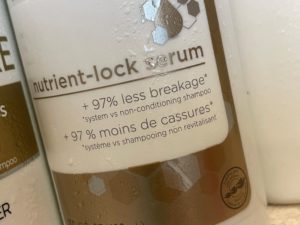
Big Pharma & Non-conditioning Shampoo
I’ve been promising a “Big Pharma Rant” for a long time, and today I’m really inspired. Well, I’m inspired enough to start – I think it’s going to end up being a few mini-rants, which is probably better anyway.
Here we go. See this conditioner bottle? (Yes, this post is born from an honest-to-goodness “shower thought.”) These folks did research, so that they could print the results on their bottle and get you to buy it.
97% less breakage*
With an asterisk. Geez, at least they put an asterisk and then tell you right then and there what it’s compared to…. the mega-super-ultra-anti-breakage-shampoo-plus-conditioner-used-as-a-system vs. a non-conditioning shampoo.
Listen, that’s not a super fair comparison. Using a non-conditioning shampoo is probably actually even worse for breakage than using no shampoo at all, but does anyone who is looking for super-ultra-mega-anti-breakage conditioner not already use conditioner? Don’t you really want to know if this conditioner is better than your regular conditioner?!
(Side note: They pretty much all do this, and so I’m not really calling out a specific brand. If you recognize this bottle, I actually happen to love it and would highly recommend.)
Ok, how does this relate to Big Pharma? Well, pharmaceutical companies often will compare their active medication product to a placebo. And that’s certainly better than not doing that. But that’s not REALLY what you want to know, is it? Don’t you want to know if an antidepressant (with all of its attendant side effects) improves depression more than, say, a 10,000 lux lamp that costs $40 and you only have to buy once? Or more than walking 3x/week? Or 16 weeks of CBT? Or, heaven forbid – a course of psychodynamic therapy?! Don’t you really want to know that before you spend thousands of dollars out of pocket getting transcranial magnetic stimulation? Or before they add an antipsychotic medication to your regimen? (This isn’t even getting at things like how long the benefits of medications vs. therapy last and how much they cost over time. Spoiler alert – therapy’s better on both metrics!)
But they’ll never do that. In the same way that the Uber-Fancy-Conditioner won’t ever make a comparison to The-Other-Uber-Fancy-Conditioner… because they know they won’t come out on top, or they know the differences will be so small that it won’t be worth the money they put into the study. So, we have to go find that research ourselves (I’m back to pharmaceuticals, btw – I don’t imagine you’re actually going to find conditioner-research!), and sometimes help our clients evaluate it, too.
There are at least 4 more mini Big Pharma rants to come, so stay tuned! And, believe it or not, I’m not actually against the use of effective, well-prescribed, thoughtfully-considered psychotropic medication. Maybe I should I do a post about that, too.
Comment below: It would be awesome if you were to post here any additional research you come across about non-pharmaceutical treatments for depression and how they compare. There are just way too many for me to include today! Or any other comments, as always!
